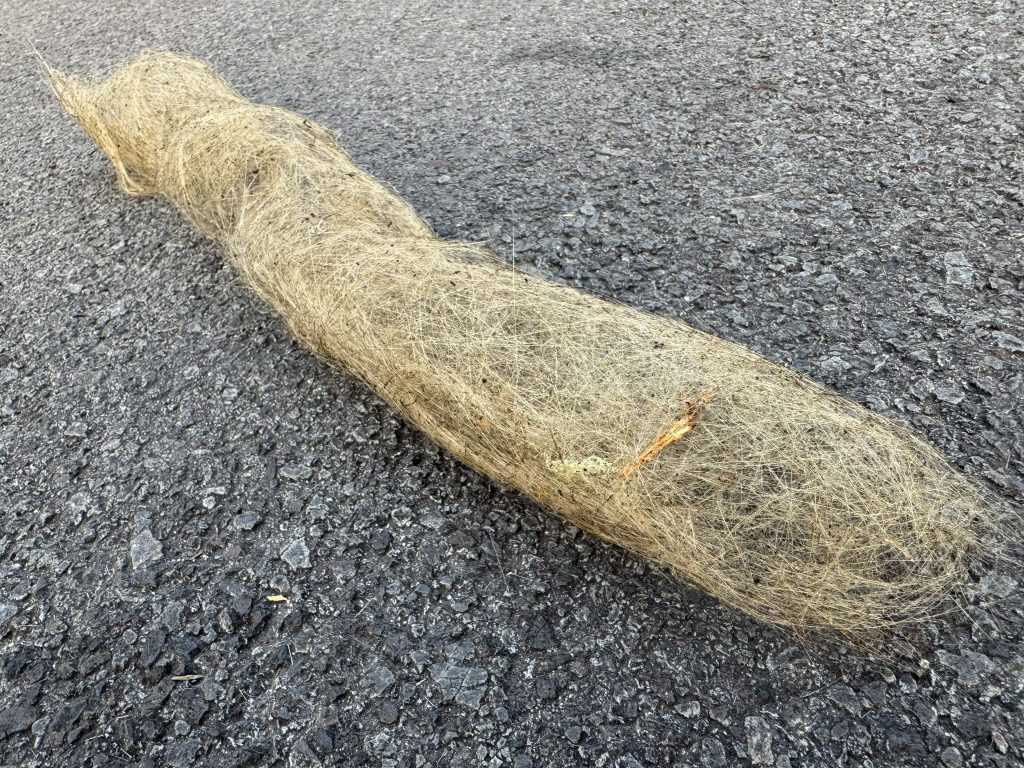Since late December 2024, residents living near the summit of Kīlauea have been witnessing spectacular lava fountains at Halemaʻumaʻu. While these eruptions are beautiful and safe to observe, they have left some community members puzzled about the glittery strands appearing on their property. This week’s #VolcanoWatch highlights the phenomenon of Pele’s Hair and the potential hazards associated with it.
Pele’s Hair is a type of volcanic glass formed when globs of liquid lava are stretched apart during an eruption. These golden strands can grow more than a meter (about 3 feet) long and be as thin as 1 millimeter (0.04 inches). Due to their lightweight nature, the strands are easily carried by the wind and can be deposited far from the eruption site.
Under typical tradewind conditions, these particles would be blown southwest from Kīlauea’s summit, reaching areas like the Kaʻū Desert in Hawaiʻi Volcanoes National Park. However, during Episode 4, which occurred from January 15 to 18, 2025, the absence of tradewinds caused the eruption plume to spread north. As a result, Pele’s Hair was deposited in areas such as Hawaiʻi Volcanoes National Park, Volcano Golf Course, Volcano Village, Mauna Loa Estates, and Ohia Estates. In some places, the strands even formed tumbleweed-like structures up to 60 cm (about 2 feet) long.
Residents may be wondering how this eruption-related debris affects vehicles, pets, children, grazing livestock, or water catchment systems. Although Pele’s Hair is similar to volcanic ash in terms of its potential hazards, it is distinct in its structure. Ash consists of particles smaller than 2 millimeters in diameter, while Pele’s Hair is usually longer and thicker. However, smaller ash-like particles may also be mixed in with Pele’s Hair, and the fragile strands can easily break into ash-sized pieces.
For grazing animals, Pele’s Hair may have an impact, although studies on this are limited. If you are concerned, consider supplementing your animals’ feed or relocating them temporarily to areas where Pele’s Hair has not fallen. In the long term, Pele’s Hair could even be beneficial for pasture growth.
The most recent eruption episode deposited less than 1 millimeter (a fraction of an inch) of Pele’s Hair in affected communities. While this amount is generally not cause for concern, it’s advisable to stay aware in case more material accumulates or falls in the future.
For residents, a simple way to check the amount of Pele’s Hair in your area is to inspect flat surfaces like the hood of a parked vehicle. If you find any particles, it’s recommended to rinse them off with water, particularly from windows and door handles, as they could scratch paint and metal.
Both Pele’s Hair and volcanic ash are abrasive and can irritate the eyes, skin, and respiratory system. If exposure is unavoidable, it’s a good idea to wear protective clothing or gear such as gloves, eye protection, and a facemask. Rainfall and wind will naturally remove the material over time, or plants may help bind it to the soil.
For those with water catchment systems, the recent amount of Pele’s Hair should not cause significant issues for most general filtration systems. However, to prevent contamination of water tanks during future lava fountain episodes, it’s recommended to disconnect your downpipe from your gutter system while Pele’s Hair is falling. After rainfall or rinsing, the roof and downpipe will be cleared, and the downpipe can be reconnected to your tank.
Pele’s Hair deposition patterns depend on both eruptive activity and wind conditions. With five fountaining episodes already recorded, monitoring data suggests that this type of eruption could continue. If you live near the active eruption, it’s important to remain aware of potential changes and reach out to askHVO@usgs.gov with any questions or concerns.

